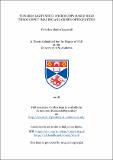Files in this item
Towards light sheet microscopy-based high throughput imaging and CRISPR optogenetics
Item metadata
| dc.contributor.advisor | Reynolds, Paul Andrew | |
| dc.contributor.advisor | Antkowiak, Maciej | |
| dc.contributor.author | Gasparoli, Federico Maria | |
| dc.coverage.spatial | 238 p. | en_US |
| dc.date.accessioned | 2018-11-14T12:47:06Z | |
| dc.date.available | 2018-11-14T12:47:06Z | |
| dc.date.issued | 2018-12-06 | |
| dc.identifier.uri | https://hdl.handle.net/10023/16448 | |
| dc.description.abstract | High Throughput Imaging (HTI) has an important role in the High Throughput/Content Screening process (HTS/HCS). It is widely used in the drug discovery process and in a wide range of other applications including studies focused on cell cycle, cell proliferation, cell migration, apoptosis, protein expression, protein localization, signalling pathways or stem cell development and differentiation. Nowadays, most of the HCS experiments are performed on two-dimensional (2D) monolayer of cells cultured on planar plastic substrates which do not reflect the complex 3D architecture of a living tissues where the cells interact between each other and with the ExtraCellular Matrix (ECM). Currently, the state-of-the-art HCS systems that can be used for high throughput imaging of 3D cell culture models are based on confocal microscopy. Even though very efficient, these machines can reach the million-dollar price and thus might be affordable to big industry and phenotypic screening centres but not to most of smaller realities such as academic laboratories. This thesis project proposes a solution to link light sheet microscopy, one of the best techniques for the imaging of 3D cell culture models, with the currently available HTS/HCS platforms: the development of the affordable and user-friendly HT-LISH microscope first prototype have the potential to offer automated light sheet microscopy-based HTI capabilities for the study of 3D samples to industries, screening centres and also to smaller laboratories, where a lower throughput level is eventually required. Another important part of this PhD thesis is focused on CRISPR-based genome editing which during the recent decades has become an invaluable tool in cell and tissue biology. CRISPR interference (CRISPRi) and activation (CRISPRa) systems have been developed to allow the users to up-or down-regulate any gene of interest in a relative simple manner. Even though emerged as powerful techniques to regulate the gene expression levels, these tools lack in spatiotemporal resolution. In order to study and understand genetic patterns specific to a certain type of tissue it is important to achieve a precise control over the CRISPRi/a systems so that they can be selectively targeted to small populations of cells (spatial resolution) or be activated and de-activated at will (temporal resolution). This work, describes the development and the characterization of the Red Light CRISPR system, a novel CRISPR-based tool for precise gene regulation experiments that relies on the interaction of the Phytochrome B (PhyB) and Phytochrome-Interacting Factor 6 (PIF6), two light sensitive protein from the plant Arabidopsis Thaliana that dimerize under red light at 660 nm and separate when illuminated with infrared light at 740 nm. The Red Light CRISPR system fuses together the non-invasive and highly spatiotemporal resolved technique of optogenetics with the “easy to use” and efficient CRISPR approach. This system is thus joining the already available range of optogenetics tools that enable a precise spatiotemporal control of the CRISPR system and, in particular, it introduces for the first time a red/infrared lightbased CRISPR inducible system. | |
| dc.language.iso | en | en_US |
| dc.publisher | University of St Andrews | |
| dc.subject.lcc | R857.O6G2 | |
| dc.title | Towards light sheet microscopy-based high throughput imaging and CRISPR optogenetics | en_US |
| dc.type | Thesis | en_US |
| dc.contributor.sponsor | University of St Andrews. Ashworth Legacy | en_US |
| dc.contributor.sponsor | Wellcome Trust. Institutional Strategic Support Fund (ISSF) | en_US |
| dc.type.qualificationlevel | Doctoral | en_US |
| dc.type.qualificationname | PhD Doctor of Philosophy | en_US |
| dc.publisher.institution | The University of St Andrews | en_US |
| dc.identifier.doi | https://doi.org/10.17630/10023-16448 |
This item appears in the following Collection(s)
Items in the St Andrews Research Repository are protected by copyright, with all rights reserved, unless otherwise indicated.

